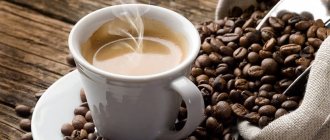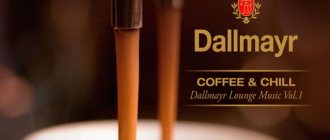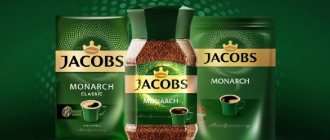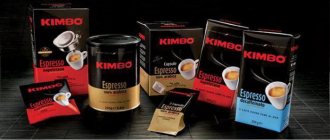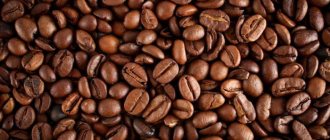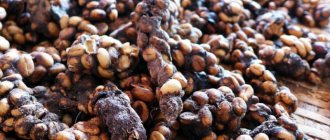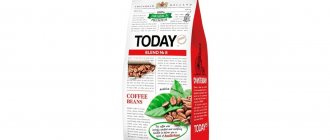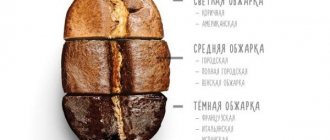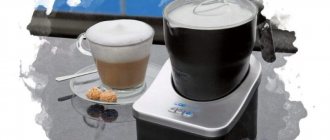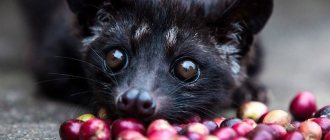Main coffee varieties
Arabian and Congolese coffee trees are widely cultivated. Their beans are used to produce the most beloved coffee varieties - Robusta and Arabica. Bengal and Cameroon trees are also grown in small quantities.
In total, there are 4 main types of coffee:
- Arabica.
- Robusta.
- Liberica.
- Excelsia.
Coffee trees are cultivated on an industrial scale in countries with a predominant tropical climate. Wild coffee trees are found on the hills of Asia and Africa. Absolutely all parts of coffee trees contain caffeine, a substance produced by plants as a biological weapon to repel parasites.
Blooming coffee is something incredible! An abundance of small white flowers with a pleasant fruity scent.
The flowers themselves are bisexual, capable of independent pollination. Coffee fruits ripen within 3-4 months. When ripe, these are mostly dark red elliptical berries, under the skin of which there are greenish-gray grains. Each fruit usually contains two seeds, but occasionally there is one, but a very large one. These seeds are called pearl seeds; they are selected separately and are highly valued. Such grains are roasted more evenly and their taste is more subtle. Special connoisseurs of coffee as a drink prefer pearl beans for its preparation.
Coffee beans grown in different countries and in different areas have their own unique characteristics (aroma, coffee strength, taste). The special characteristics of the beans are determined not only by the type of coffee trees, but also by agricultural cultivation techniques and environmental conditions. This means that the properties of coffee beans of the same variety can vary significantly from plantation to plantation. Single-origin is the name given to coffee that originates in the same area.
Currently, mainly small-sized coffee trees are cultivated. This is due to the convenience of care and harvesting. Coffee trees prefer light, moderately moist soil, rich in elements such as nitrogen, phosphorus oxide and potassium carbonate, and moist air. Such conditions contribute to obtaining the most valuable drink in terms of taste characteristics.
Blue Mountain, Jamaica
This variety is not only the strongest coffee in the world, but also one of the most expensive. The plantations where coffee trees are grown are located at an altitude of 1200 km above sea level. It is quite difficult to buy real Blue Mountain, since the bulk of the harvest is exported to Japan.
Despite its strength, this variety has virtually no bitterness. Blue Mountain has an old wine aroma and a rich finish. This variety of Jamaican coffee belongs to the elite and expensive varieties, so fakes are very often found on our market.
All types of coffee are divided into pure and mixed
Mixed are compositions of several types of ground coffee. Grains are mixed in order to emphasize the positive characteristics of one or another type, as well as to mask shortcomings. When mixing, they try to select coffee varieties that reveal and complement each other’s taste characteristics. Usually, grains with similar taste qualities or, conversely, with extremely polar ones, are not mixed. The mixed form contains from two to fifteen varieties of ground grains.
Pure varieties are varieties that contain only one type of coffee bean. These species are named after the area where the coffee trees grew. For example, Brazilian coffee.
Dependence of the strength of coffee beans on roasting
Roasting the beans is the first important step in coffee making. As a result of roasting, coffee tree beans fully reveal their aroma, taste and strength. The stronger the roast, the stronger the drink. Coffee acquires its usual dark brown color during heat treatment due to sucrose, which under the influence of temperatures is converted into caramel. Equally, during the roasting process, the structure of the grain itself changes, which helps the release of essential oils.
Types of coffee roast levels:
The light or Scandinavian level of processing is characterized by the light brown color of the coffee beans, a rich, light taste with a strong acidity and a subtle pleasant aroma. The drink, made from lightly roasted beans, is perfect for drinking with cream and milk. The strength of this coffee is low.
Viennese, or medium roasting helps color the beans in the rich colors of milk chocolate, revealing bittersweet with a slight sourness tones in the taste. This drink goes well with milk and is just as good on its own.
The medium-high, or French, roast level imparts a rich, chocolatey hue to the coffee beans. Each grain is covered with a thin film of essential oils. The taste of coffee after this degree of roasting becomes even more bittersweet and rich, and the characteristic sourness disappears almost completely.
A strong, or Italian, level of roasting colors the beans in a dark brown hue and contributes to the appearance of a thick, oily film on the surface of the beans. The taste of this coffee is characterized by bitter, slightly “scorched” pleasant tones. The aroma of grain after the Italian roasting method becomes truly luxurious.
Espresso-level roasting is used for beans intended for the coffee drink of the same name. After this roasting, the grain becomes black, shiny, and very oily. Espresso coffee has the highest strength. Coffee connoisseurs all over the world prefer this particular drink for its unique deep bitter “charred” taste and thick smell. The grinding of espresso beans is very fine, since the strength of the coffee depends equally on the grinding.
Small result
What determines the strength of coffee:
- From the variety - the higher the caffeine content in the variety, the stronger the drink will be.
- Depending on the roast level – the darker it is, the richer the coffee.
- From the size of the grind - the finer the grind, the easier the coffee gives all the flavoring and aromatic substances, which means it becomes stronger.
- Depending on the brewing method, the strongest drink comes from coffee machines.
How grinding degree affects the taste of coffee.
The degree of grinding of coffee beans is an important factor that, in addition to the properties, variety and roasting of coffee beans, directly affects the taste. If you want to get a truly delicious coffee, you need to know how the degree of grinding affects the taste of the coffee.
What does the word “strong” mean for coffee?
Strength is the concentration of a certain taste (sweet, sour, salty or bitter) or flavor mixture. Coffee is characterized mainly by its bitter taste. Therefore, the more bitter the taste of the drink, the stronger it is considered. This opinion is wrong. The body (strength) of coffee drinks is determined by the number of taste buds it irritates. From this it follows that coffee requires the presence of different tastes. Drinks made from coffee beans have sweet, sour and bitter flavors; they have virtually no salty taste.
It turns out that the more concentrated the flavors, the stronger the coffee. Of course, the richness of the aroma is an important component of the strength of the coffee, as is the richness of the extractives in the solution. The more a coffee drink is diluted with liquid, the lower its flavor strength. In this case, the amount of extractives will remain unchanged. This is how the coffee strength is adjusted.
Who shouldn't drink
Caffeine, which is part of the drink, is an invigorating and tonic substance. There can be a lot of discussion about how it is perceived by the human body, but it is important to remember that even the healthiest product is useful in moderation.
Caffeine strains the cardiovascular system
It is harmful, for example, to drink on an empty stomach for those people who suffer from gastritis or stomach ulcers. Those who suffer from hypertension (regardless of the functional class of the disease) may increase their blood pressure when drinking coffee. With this disease, there is an increased load on the blood vessels and heart, and caffeine will only increase this load.
Even if there are indirect contraindications, the drink can be consumed, but in moderation. You can also choose a variety or coffee drink with less caffeine to reduce or prevent possible negative effects.
- Espresso, cappuccino, latte, Americano: differences
Methods for brewing coffee drinks
In the coffee pot. The easiest way to prepare the drink, but also the least popular. The brewing principle consists of simply pouring boiling water and infusing coarsely ground coffee beans. There are also piston or French coffee pots. These are tall glass coffee pots with piston lids.
In Turks or cezves. A method whose inventors are Arabs. The principle of preparation is to pour very finely ground coffee beans with cold water and slowly bring the drink to a boil (but do not boil).
Using filtering. This method is used in drip coffee makers. The filtration method involves filtering one drop of water through ground coffee beans placed in disposable paper or reusable stationary filters.
In the coffee machine. The method is based on the injection of hot steam under high pressure through finely ground coffee. The strength of coffee in a coffee machine is noticeably higher, since it is forcibly brewed under high pressure. Good espresso is quite expensive in price. This is due to the high cost of coffee machine mechanisms.
In a geyser type coffee maker. The devices consist of three compartments. The bottom one is for water, the middle one is for coarse coffee beans, the top one is for the coffee drink itself. The brewing principle is based on the passage of hot water and steam through the grain. The advantage of this brewing method is the absence of coffee grounds in the finished drink.
A little about Robusta
Coffee consistencies containing robusta or even untainted robusta feel more bodyful. This is determined by the chemical composition of the grains. They contain special substances that are more irritating to taste sensors. The caffeine content in robusta reaches almost 5%. Caffeine is a bitter-tasting substance, and it accordingly adds bitterness to robusta beans. Robusta also tends to brew faster than Arabica. This increases the amount of extractives in the finished drink.

